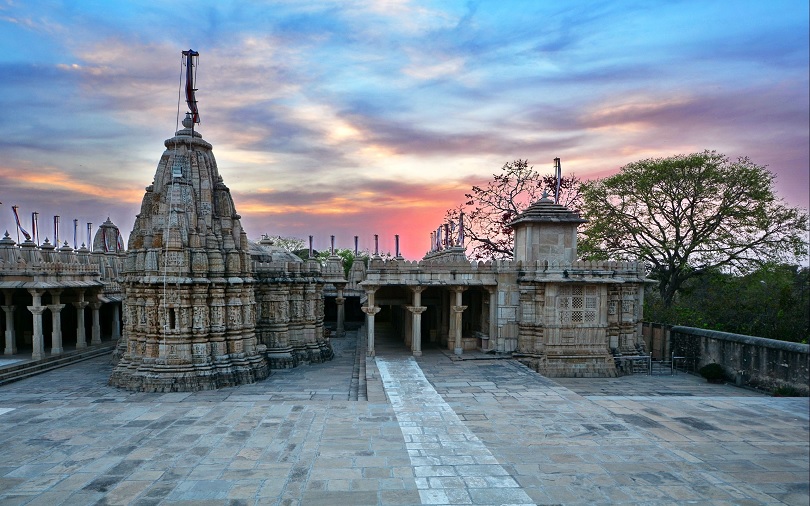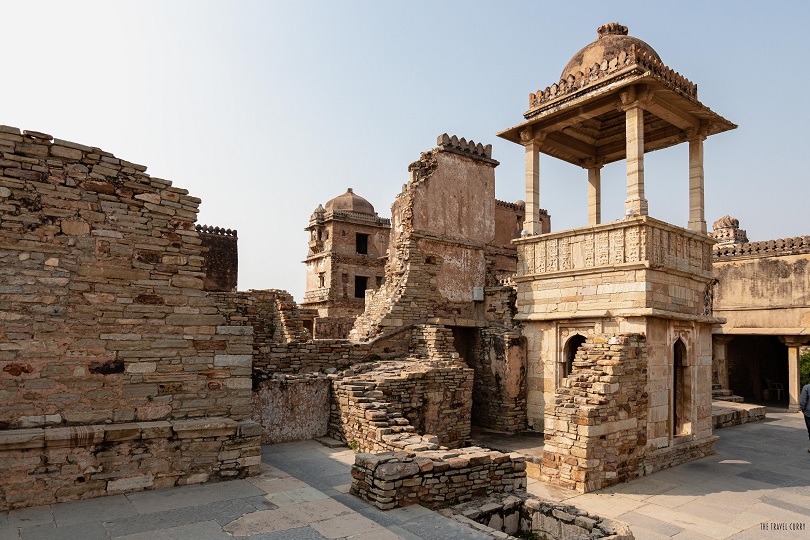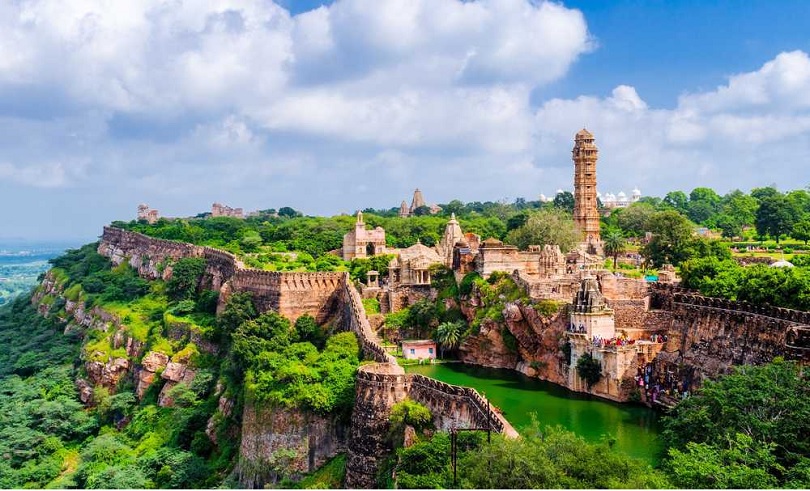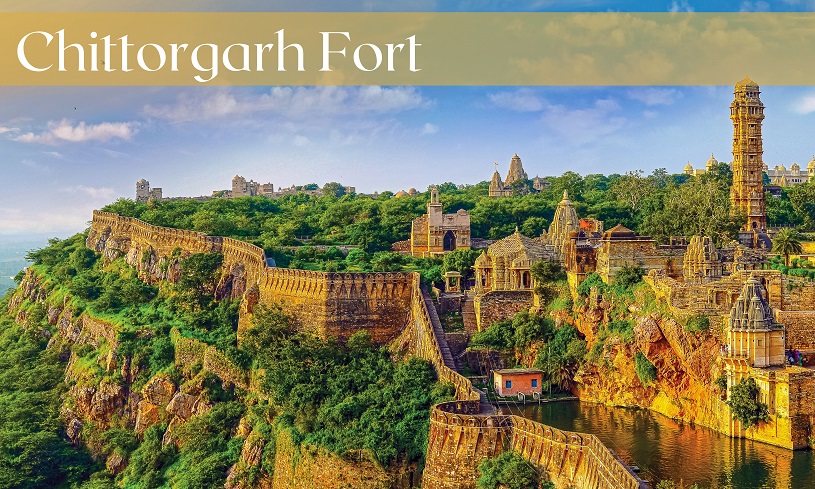Rajasthan has a rich history shrouded in valour and pride. The numerous forts and palaces that dot the state are a testament to its iconic past and cultural heritage. Whether it is the majestic Amer Fort of Jaipur or the opulent City Palace of Udaipur, every remarkable landmark of Rajasthan is highly significant to the state and the country’s history. The events and wars that took place at these iconic forts shaped our history as we know it today.

Chittorgarh Fort is a significant landmark reminiscent of the Rajputana pride and bravery. Located at a height of 590 feet, this massive fortress is spread across almost 700 acres and has impeccable Rajput architecture. The fort, which was declared a UNESCO World Heritage Site in 2013, is said to have been built by the local Maurya rulers in 7 century A.D. Furthermore, the structure was expanded with several gateways. Formerly the fort had 84 waterbodies, earning it the title of Water Fort. However, now there are only 22 water bodies left in the fort. Some of the other notable attractions in the fort include the 1km steep entry road that leads up to the fort, Kirti Stambh, Vijay Stambh and Meera Temple.
Chittorgarh Fort Ticket Price: INR 35/- (Indian ) & INR 550/- (Foreigners)
Chittorgarh Fort Timings: 6:00 AM to 6:00 PM
Best Time To Visit: October To March
Read on to learn more about the exciting stories, the rich history and the numerous attractions that make Chittorgarh Fort a must-visit tourist attraction.
Also Read: Things You Need to Know about City Palace Udaipur
Chittorgarh Fort: History

The history of Chittorgarh Ka Kila is fascinating and remarkable. The inception of the fort itself has two folklore attached to it, with one being associated with Chitranga, a ruler of the local Maurya or Mori clan. The other story attributes the fort’s construction to Bhima, who aided the surfacing of Bhimlat Kund by striking the ground.
Chittorgarh Fort, formerly the capital of Mewar, was captured thrice between the 15th and 16th centuries, including the famous siege by Alauddin Khilji in 1303, which resulted in the Jauhar (mass self-immolation) of the women and children of the fort. Further, in 1533, Bikramjeet Singh was defeated by the Bahadur Shah, the Sultan Of Gujarat and in 1568, Akbar defeated Maharana Udai Singh II. The fort was returned to the Rajput rulers in 1616 under Mughal Emperor Jahangir.
Chittorgarh Fort: Architecture
Chittorgarh Fort is an architectural marvel which was built in the 7th century and covers an area of approximately 700 acres. The fort’s architecture reflects the Rajput construction style, characterized by intricate carvings, beautiful sculptures, and intricate latticework. The fort is made up of several palaces, temples, gates, and towers, each with its unique style and design. Some prominent structures within the fort include the Vijay Stambha (Victory Tower), Kirti Stambha (Tower of Fame), Rana Kumbha Palace, Padmini Palace, and the Meera Temple. The fort is also surrounded by a moat and has several massive gates that once served as the main entrance to the fort.
Chittorgarh: Attractions

- Rani Padmini’s Palace: Built on the bank of the lotus pool, Rani Padmini’s Palace had a pavilion for privacy for the royal ladies. It was at this pool that Ala-ud-din Khilji caught a glimpse of Rani Padmini and was besotted by her beauty.
- Light And Sound Show: This traditional show depicts the fort’s history, including its foundation, rulers and the wars that took place here.
- Vijay Stambh: Maharana Kumbha built the Tower of Victory between 1440 AD and 1448 AD to commemorate his victory over Muslim rulers. The nine-storeyed tower is made out of red sandstone and white marble and decorated with intricate structures of Hindu Gods and Goddesses.
- Kirti Stambh: Built in the 12th century AD, Kirti Stambh is dedicated to Adinathji, the 1st Jain Tirthankara. The seven-storeyed Tower of Fame was built by a wealthy Jain merchant and has detailed sculptures of Jain monks.
- Fateh Prakash Palace: Maharana Fateh Singh built this palace as his residence, showcasing his appreciation for art and culture. The palace boasts a wide range of exhibits, including wooden crafts from Bassi village, medieval Jain Ambica and Indra statues from Rashmi village, weapons, clay replicas of regional tribal people wearing traditional costumes, paintings, and crystal ware. The palace has since been transformed into a museum.
- Jain Temples: Chittorgarh Fort Udaipur has six Jain temples, and Bhagwan Adinatha, the largest temple, has 52 ‘devkulikas’.
- Gaumukh Reservoir: A deep tank fed by a spring, Gaumukh Reservoir is considered sacred by the locals and is a must-visit attraction at Chittor.
- Ratan Singh Palace: Overlooking a small lake, this was the winter palace of the royal family and is an exciting place to visit.
- Rana Kumba Palace: One of the most important monuments within Chittor, this ruined edifice is believed to be the palace where Rani Padmini and other women performed ‘Jauhar,’ a self-immolation ritual.
- Meera Temple: Built in a classic North Indian style of architecture, this temple is dedicated to Meerabai, an ardent devotee of Lord Krishna. It is believed that she worshipped the Lord at this temple.
If you are planning a trip to Udaipur soon, it is only fitting to include a visit to the majestic Chittorgarh Fort in your itinerary. Make this vacation more memorable by booking a stay with us at The LaLiT Laxmi Vilas Palace Udaipur. Our traditional property is equipped with new-age and luxurious amenities to make your stay fun-filled and comfortable.

